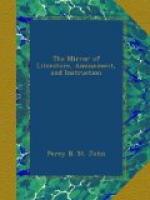There are twelve engravings and a presentation plate. Among the most beautiful of these are Cupid and Psyche, painted by J. Wood, and engraved by Finden; Campbell Castle, by E. Goodall, after G. Arnald; the Parting, from Haydon’s picture now exhibiting with his Mock Election, “Chairing;” Hours of Innocence, from Landseer; La Frescura, by Le Petit, from a painting by Bone; and the Cove of Muscat, a spirited engraving by Jeavons, from the painting of Witherington. All these are of first-rate excellence; but another remains to be mentioned—Glen-Lynden, painted and engraved by Martin, a fit accompaniment for Mr. Pringle’s very polished poem.
The first prose story is the Election, by Miss Mitford, with the hero a downright John Bull who reads Cobbett. The next which most attracts our attention is Contradiction, by the author of an Essay on Housekeepers—but the present is not so Shandean as the last-mentioned paper; it has, however, many good points, and want of room alone prevents our transferring it. Then comes the Covenanters, a Scottish traditionary tale of fixing interest; the Publican’s Dream, by Mr. Banim, told also in the Winter’s Wreath, and Gem:
Thrice the brindled cat hath mewed;
and Zalim Khan, a beautiful Peruvian tale of thirty pages, by Mr. Fraser. The French story, La Fiancee de Marques, is a novelty for an annual, but in good taste. Tropical Sun-sets, by Dr. Philip, is just to our mind and measure:—
A setting sun between the tropics is certainly one of the finest objects in nature.
From the 23rd degree north to the 27th degree south latitude, I used to stand upon the deck of the Westmoreland an hour every evening, gazing with admiration upon a scene which no effort either of the pencil or the pen can describe, so as to convey any adequate idea of it to the mind of one who has never been in the neighbourhood of the equator. I merely attempt to give you a hasty and imperfect outline.
The splendour of the scene generally commenced about twenty minutes before sun-set, when the feathery, fantastic, and regularly crystallized clouds in the higher regions of the atmosphere, became fully illumined by the sun’s rays; and the fine mackerel-shaped clouds, common in these regions, were seen hanging in the concave of heaven like fleeces of burnished gold. When the sun approached the verge of the horizon, he was frequently seen encircled by a halo of splendour, which continued increasing till it covered a large space of the heavens: it then began apparently to shoot out from the body of the sun, in refulgent pencils, or radii, each as large as a rainbow, exhibiting, according to the rarity or density of the atmosphere, a display of brilliant or delicate tints, and of ever changing lights and shades of the most amazing beauty and variety. About twenty minutes after sun-set these splendid shooting rays disappeared, and were succeeded by a fine, rich glow in the heavens, in which




